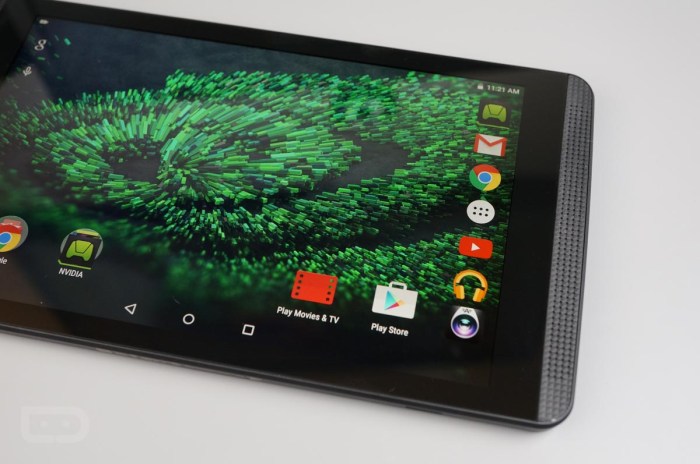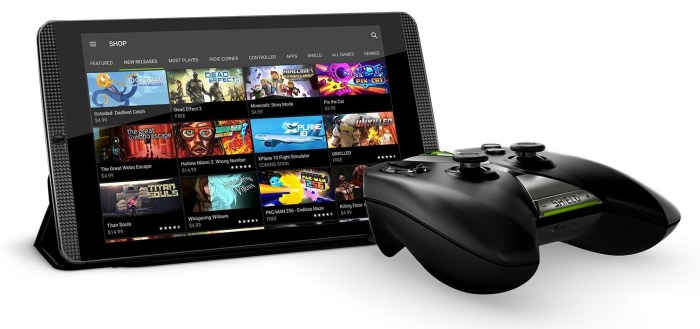The NVIDIA Shield Tablet K1
The NVIDIA Shield Tablet K1 was a groundbreaking Android tablet that made its debut in 2014, promising a powerful gaming experience and advanced multimedia capabilities. This tablet was a bold step for NVIDIA, venturing beyond its core graphics processing unit (GPU) business into the world of consumer electronics.
Key Features and Specifications
The NVIDIA Shield Tablet K1 was equipped with a Tegra K1 processor, boasting a 192-core GPU capable of delivering exceptional graphics performance. It featured a 7-inch IPS LCD display with a resolution of 1920 x 1200 pixels, providing vibrant visuals and sharp details. The tablet also boasted a 5MP rear camera and a 1.6MP front-facing camera, enabling users to capture photos and videos. The Shield Tablet K1 came with 16GB or 32GB of internal storage, expandable via microSD card, allowing users to store their games, movies, and other files.
Strengths and Weaknesses
Strengths
The NVIDIA Shield Tablet K1 was praised for its gaming capabilities, leveraging the power of its Tegra K1 processor to deliver smooth and immersive gameplay. The tablet was compatible with various Android games, including high-end titles, and supported NVIDIA’s GameStream service, allowing users to stream games from their PC to the tablet. The Shield Tablet K1 also excelled in multimedia consumption, with its high-resolution display and powerful processor enabling a smooth and enjoyable experience. The tablet’s integrated speakers delivered decent audio quality, further enhancing the multimedia experience.
Weaknesses
Despite its strengths, the NVIDIA Shield Tablet K1 had its share of drawbacks. The tablet’s battery life was criticized for being relatively short, especially when playing demanding games. Additionally, the tablet’s build quality was considered to be somewhat flimsy, making it susceptible to scratches and dents. The Shield Tablet K1 also faced competition from other tablets with similar features but more competitive pricing.
Reception and User Reviews
The NVIDIA Shield Tablet K1 received generally positive reviews upon its release. Many reviewers praised its gaming capabilities, particularly its ability to stream games from a PC using NVIDIA’s GameStream service. Users also appreciated the tablet’s performance and its multimedia features. However, some critics pointed out the tablet’s relatively short battery life and its somewhat flimsy build quality. Overall, the Shield Tablet K1 was considered a solid tablet with a unique selling proposition, particularly for gamers.
The Rumored Successor and its Cancellation: Nvidia Shield Tablet K1 Successor Cancelled
While the NVIDIA Shield Tablet K1 was a solid device, whispers of a successor began circulating in the tech community. This rumored tablet, often referred to as the “Shield Tablet K2,” was expected to bring significant improvements and build upon the foundation laid by its predecessor.
Features and Release Timeframe
The rumored Shield Tablet K2 was anticipated to feature a larger display, possibly a 10-inch screen with a higher resolution, offering a more immersive multimedia experience. Speculation also pointed towards a more powerful processor, likely an upgraded Tegra chip, enabling smoother gaming performance and enhanced multitasking capabilities. Furthermore, the tablet was expected to incorporate a more refined design, potentially incorporating a premium metal build for a more sophisticated aesthetic. While a concrete release date was never officially confirmed, rumors suggested that the Shield Tablet K2 could have arrived sometime in 2016.
Reasons for Cancellation
Despite the promising features and anticipation surrounding the Shield Tablet K2, NVIDIA ultimately decided to cancel the project. Several factors contributed to this decision, including the increasingly competitive tablet market, the declining popularity of tablets in general, and NVIDIA’s shifting strategic priorities.
The tablet market had become fiercely competitive by the mid-2010s, with established players like Apple and Samsung dominating the landscape. The emergence of affordable Android tablets from companies like Amazon and Lenovo further intensified the competition, making it challenging for NVIDIA to carve out a significant market share. Moreover, the overall tablet market was experiencing a decline in sales as smartphones continued to gain popularity and offer similar functionalities. This shrinking market made it less appealing for NVIDIA to invest in a new tablet, particularly considering the significant resources required to develop and market a competitive device.
Impact on NVIDIA’s Tablet Strategy
The cancellation of the Shield Tablet K2 marked a significant shift in NVIDIA’s tablet strategy. While the company had previously invested in the development of tablets, it ultimately decided to focus its resources on other areas, such as gaming GPUs, automotive chips, and artificial intelligence. This strategic shift reflected NVIDIA’s recognition of the evolving technological landscape and the need to prioritize areas with greater growth potential.
The Impact of the Cancellation on the Android Gaming Landscape
The cancellation of the NVIDIA Shield Tablet K1 successor sent ripples through the Android gaming landscape, particularly for enthusiasts seeking high-performance gaming devices. The absence of a new Shield Tablet left a void in the market, prompting an examination of the competitive landscape and the features offered by alternative Android gaming tablets.
The Competitive Landscape for Android Gaming Tablets, Nvidia shield tablet k1 successor cancelled
The absence of a new NVIDIA Shield Tablet left a gap in the market for high-performance Android gaming tablets. However, several other manufacturers have stepped up to fill the void, offering a range of devices with varying capabilities.
- Samsung Galaxy Tab S8 Series: Samsung’s Galaxy Tab S8 series boasts powerful processors, vibrant displays, and support for the latest gaming technologies.
- Lenovo Yoga Tab 13: The Lenovo Yoga Tab 13 offers a unique design with a built-in kickstand and a large display, making it suitable for both gaming and multimedia consumption.
- Huawei MatePad Pro: The Huawei MatePad Pro features a powerful processor, a high-resolution display, and a stylus, making it a versatile device for both productivity and gaming.
Comparing Features and Capabilities of Android Gaming Tablets
The Android gaming tablet market offers a diverse range of devices, each with its strengths and weaknesses.
| Feature | Samsung Galaxy Tab S8 Series | Lenovo Yoga Tab 13 | Huawei MatePad Pro |
|---|---|---|---|
| Processor | Qualcomm Snapdragon 8 Gen 1 | Qualcomm Snapdragon 870 | Qualcomm Snapdragon 870 |
| Display | 11-inch Super AMOLED, 120Hz refresh rate | 13-inch LCD, 2K resolution | 12.6-inch OLED, 120Hz refresh rate |
| Gaming Features | Game Launcher, Game Booster, HDR support | Dolby Atmos sound, large display for immersive gaming | M-Pencil support for precise control in games |
“While the cancellation of the NVIDIA Shield Tablet K1 successor was a setback for Android gaming, the competitive landscape has remained active, offering a variety of options for gamers seeking high-performance devices.”
The Future of NVIDIA’s Mobile Gaming Strategy
NVIDIA’s decision to abandon the Shield Tablet K1 successor left a void in the Android gaming landscape, but it also signaled a shift in their mobile gaming strategy. While the company may have stepped back from producing dedicated gaming tablets, they remain deeply invested in mobile gaming through a combination of cloud gaming services and strategic partnerships.
NVIDIA’s Cloud Gaming Focus
NVIDIA’s cloud gaming service, GeForce NOW, has become a central pillar of their mobile gaming strategy. It allows gamers to stream high-performance PC games to a wide range of devices, including smartphones, tablets, and even smart TVs. GeForce NOW’s cloud-based infrastructure eliminates the need for powerful hardware, making high-end gaming accessible to a wider audience.
“NVIDIA is committed to providing gamers with the best possible experience, and GeForce NOW is a key part of that commitment.” – NVIDIA CEO Jensen Huang
Potential for a Tablet Comeback
While NVIDIA has not explicitly announced plans to re-enter the tablet market, the company’s commitment to mobile gaming and the evolving landscape suggest potential for a return. The rise of foldable devices and advancements in mobile processors have created new possibilities for high-performance mobile gaming experiences.
Challenges and Opportunities in the Mobile Gaming Market
NVIDIA faces stiff competition from other tech giants in the mobile gaming space, including Google, Apple, and Samsung. These companies are investing heavily in their own gaming platforms and services, creating a highly competitive environment. However, NVIDIA’s strengths in graphics processing and cloud gaming technology provide them with a unique advantage.
“NVIDIA’s focus on cloud gaming and partnerships positions them well to capitalize on the growing mobile gaming market.” – Analyst at IDC
Nvidia shield tablet k1 successor cancelled – The cancellation of the NVIDIA Shield Tablet K1 successor was a disappointment to many gamers. However, it is important to remember that NVIDIA is still committed to mobile gaming. The company has recently announced a new cloud gaming service called GeForce NOW, which allows users to stream games from the cloud to their mobile devices. This service is still in its early stages, but it has the potential to revolutionize mobile gaming. It remains to be seen whether NVIDIA will ever release a new Shield Tablet, but the company is clearly still interested in the mobile gaming space.
The news of the Nvidia Shield Tablet K1 successor being cancelled might be a bummer for gamers, but the latest Watch Dogs 2 video showcasing DedSec’s hacking skills could be a silver lining. This new video highlights the game’s focus on digital espionage and rebellion, which might just be the kind of high-tech thrill we need to forget about that cancelled tablet.
Maybe Nvidia will take inspiration from Watch Dogs 2 and build a new tablet that’s truly worthy of a hacker’s attention.
 Standi Techno News
Standi Techno News

